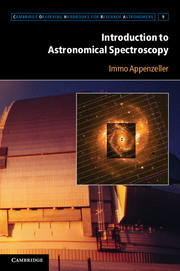Book contents
- Frontmatter
- Contents
- Preface
- 1 Historical Remarks
- 2 Spectroscopy in Present-Day Astronomy
- 3 Basic Physics of Spectral Measurements
- 4 Optical-Range Grating and Prism Spectrometers
- 5 Other Techniques for the Optical Spectral Range
- 6 Preparing and Reducing Optical Observations
- 7 UV, X-Ray, and Gamma Spectroscopy
- 8 Spectroscopy at Radio Wavelengths
- 9 Special Techniques of the FIR and Submillimeter Range
- 10 New Developments and Future Prospects
- Appendix: List of Acronyms
- References
- Index
5 - Other Techniques for the Optical Spectral Range
Published online by Cambridge University Press: 05 January 2013
- Frontmatter
- Contents
- Preface
- 1 Historical Remarks
- 2 Spectroscopy in Present-Day Astronomy
- 3 Basic Physics of Spectral Measurements
- 4 Optical-Range Grating and Prism Spectrometers
- 5 Other Techniques for the Optical Spectral Range
- 6 Preparing and Reducing Optical Observations
- 7 UV, X-Ray, and Gamma Spectroscopy
- 8 Spectroscopy at Radio Wavelengths
- 9 Special Techniques of the FIR and Submillimeter Range
- 10 New Developments and Future Prospects
- Appendix: List of Acronyms
- References
- Index
Summary
Although the grating instruments discussed in the preceding chapter dominate present-day astronomical spectroscopy at optical wavelengths, currently there are several other techniques in use at ground-based and space-based observatories. This chapter outlines the principles, the present applications, and the potential of three of these alternative methods.
Fabry-Perot Techniques
Fabry-Perot (FP) devices are based on the interference of light rays that are multiply reflected between partially transmissive mirrors. In astronomy, the main applications of the FP technique are special spectrometers and narrowband interference filters. FP spectroscopy was developed in the final years of the nineteenth century by the French physicists Charles Fabry and Alfred Perot. The technique was soon applied to astronomy. Alfred Perot himself used this method for measuring motions in the solar atmosphere.
The basic principle of the FP technique is outlined in Figure 5.1. The heart of any FP device is a pair of partially transmissive mirrors, separated by the distance l. In the context of FP devices, such a mirror pair is called an etalon (from the French designation of a standard length). In Figure 5.1, the light rays from the telescope are assumed to enter the space between the mirrors at angles γ to the mirror normals from the left (A). As indicated in the figure, the partially transmissive mirrors result in multiple reflections at the two mirror planes. At each reflection a fraction of the light passes through the mirror, while another fraction is returned into the space between the mirrors.
- Type
- Chapter
- Information
- Introduction to Astronomical Spectroscopy , pp. 127 - 144Publisher: Cambridge University PressPrint publication year: 2012



